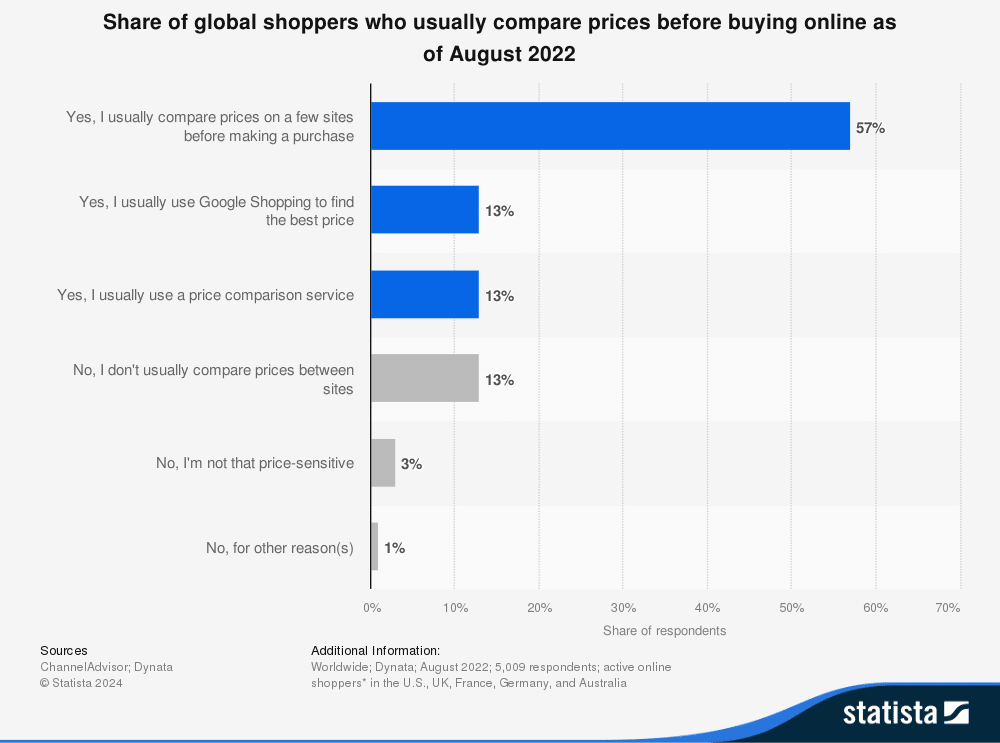Price Management: A Key Lever to Boost E-Commerce Performance
24/01/25
5'
In a constantly evolving market where competition is fierce and consumer expectations are rapidly changing, price management has become a strategic pillar for retailers and e-commerce players. Adopting an effective price management solution not only helps optimise profit margins but also enhances competitiveness in an ultra-dynamic market.
In this article, we will explore why price management is essential, the strategic approaches to adopt, and the benefits of using a tailored solution. Finally, we will discuss how such a solution can support merchants in their digital transformation to maximise their performance.
Why Is Price Management Crucial in E-Commerce?
The Battle of Prices in E-Commerce
In e-commerce, where price is often the number one criterion for consumers, 83% of shoppers compare prices before making a purchase (Source: Statista, chart below). On marketplaces like Amazon, eBay, or Temu, where millions of sellers compete for attention, a poor pricing strategy can quickly lead to a loss of market share.
Non-competitive or poorly adjusted prices also affect profitability: pricing errors can directly reduce company margins. Excessive promotions, prices set too low, or insufficient responsiveness to competition can limit performance and hinder sales.

The Impact on Competitiveness and Perception
Consumers, using tools like Google Shopping or Idealo, can easily find cheaper alternatives. On Amazon, the Buy Box algorithm often prioritises sellers with the most competitive prices, making dynamic price management essential to maintain visibility and attract customers.
Additionally, price perception plays a significant role: prices that are too low may suggest poor quality, while prices that are too high, if not justified by perceived value, risk driving buyers away.
Adopting a price management solution allows businesses to respond quickly to market fluctuations, optimise profit margins, and strengthen competitiveness in a marketplace where every penny matters.
Strategic Approaches for Effective Price Management
To maximise sales and protect your margins, effective price management relies on strategies tailored to your market and target audience. Whether your focus is on volume, differentiation, or responding to competitive pressures, choosing the right pricing approach can make all the difference. Below are the key strategies to align your pricing with your business goals:
Cost-Based Pricing
This traditional method involves setting prices based on production costs plus a predefined profit margin. While effective for covering costs, it often overlooks market dynamics and customer expectations, potentially limiting competitiveness.
Competitive Pricing
This approach involves adjusting prices based on market rates. E-commerce businesses, for example, routinely monitor competitors’ pricing for similar products to remain competitive. Staying aligned with market trends ensures that your offerings remain attractive to consumers.
Dynamic Pricing
A modern, flexible approach where prices are adjusted in real time based on multiple factors, such as demand, seasonality, consumer behaviour, or stock levels. Companies like Uber and Amazon have successfully adopted this strategy to maximise profits and adapt to fluctuating market conditions.
By leveraging these pricing strategies, businesses can maintain their competitiveness while aligning their pricing with customer expectations and market demands.
Why Invest in a Price Management Solution?
In an increasingly competitive e-commerce landscape, manual price management is no longer sufficient to stay ahead. Investing in a price management solution allows businesses to automate processes, gain actionable insights, and respond to market changes with agility. Here’s why such a solution is essential:
1. Automation and Time Savings
A price management solution automates the collection and analysis of market data, including competitor prices, customer behaviour, and demand fluctuations. This saves countless hours of manual work and reduces the risk of human error, enabling teams to focus on strategy rather than operations.
2. Margin Optimisation
Effective solutions dynamically adjust prices based on predefined rules, such as margin thresholds or competitive positioning. Productpine, for example, increased sales of its most competitive products by 15%.
3. Real-Time Responsiveness
Market conditions can change rapidly due to demand surges, stock fluctuations, or competitive promotions. A pricing solution provides real-time updates and ensures that your prices remain competitive and aligned with market trends, even during volatile periods.
4. Data-Driven Decision Making
With access to detailed analytics and dashboards, businesses can gain insights into pricing performance, competitor trends, and customer buying patterns. This empowers decision-makers to refine their strategies and identify new opportunities for growth.
5. Consistency Across Channels
In today’s omnichannel world, maintaining consistent pricing across e-commerce sites, marketplaces, and physical stores is critical to avoid customer confusion or dissatisfaction. A centralised pricing solution ensures coherence and eliminates discrepancies across platforms.
An Advanced Solution to Optimise Price Management

In a context where price competitiveness is crucial, NetRivals, a solution by Lengow, positions itself as a key tool for e-merchants and retailers aiming to optimise their price management strategy.
This platform stands out for:
- Comprehensive competitive monitoring: NetRivals collects and analyses real-time pricing data from over 32,000 e-commerce sites and 2 billion products, providing a clear and up-to-date view of the market.
- Automated price management: Using intelligent algorithms, the platform adjusts prices based on defined criteria such as margin objectives or competitiveness thresholds.
- Actionable reports: The provided dashboards and analyses offer detailed insights into pricing trends and opportunities, enabling informed decision-making.
- Seamless integration: Compatible with major information systems (ERP, CRM, PIM), NetRivals ensures effective product data synchronisation and centralised management.
With NetRivals, e-merchants gain a powerful solution to refine their pricing strategies, adapt to market fluctuations, and support their growth in a competitive environment.
Your e-commerce library
Sign up for our newsletter
By submitting this form you authorize Lengow to process your data for the purpose of sending you Lengow newsletters . You have the right to access, rectify and delete this data, to oppose its processing, to limit its use, to render it portable and to define the guidelines relating to its fate in the event of death. You can exercise these rights at any time by writing to dpo@lengow.com

Trending Posts
Marketing channels
ChatGPT Ads and advertising on GenAI Search Engines: what you need to know
Advertising on generative AI-based search engines (GenAI) marks a new era in digital marketing. After two decades dominated by traditional…
22/05/25
6'
Marketing channels
Reddit and Social Commerce: When Users Take Back Control
Before buying anything, we compare. We hesitate. And more and more often, we end up typing the product name followed…
30/06/25
8'
Marketing channels
How to Sell on TikTok in 2025: The Ultimate Guide to Success
To sell or not to sell on TikTok? That remains a question many brands ask themselves. But here’s what you…
03/02/25
7'
E-commerce Trends
E-Commerce 2025: The New Rules of Digital Retail
What’s going on in e-commerce? A lot. If 2024 was the year brands got comfortable with marketplaces, AI tools, and…
11/07/25
8'
Marketing channels
Omnichannel Strategy: The Best Examples of Successful Brands
Consumers interact with brands through multiple channels, including online, in-store, and mobile apps. More than 90% of consumers expect a…
04/04/25
5'




